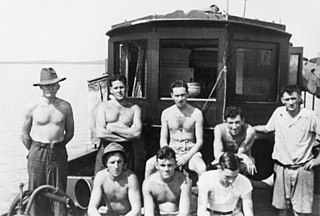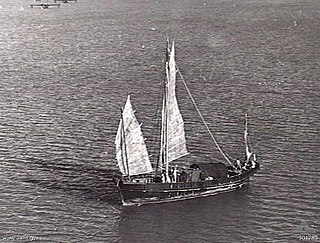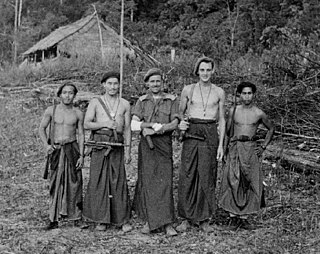A folding kayak is a direct descendant of the original Inuit kayak made of animal skins stretched over frames made from wood and bones. A modern folder has a collapsible frame made of some combination of wood, aluminium and plastic, and a skin made of a tough fabric with a waterproof coating. Many have integral air chambers inside the hull, making them virtually unsinkable.

Operation Jaywick was a special operation undertaken in World War II. In September 1943, 14 commandos and sailors from the Allied Z Special Unit raided Japanese shipping in Singapore Harbour, sinking six ships.

The Borneo campaign of 1945 or Second Battle of Borneo, was the last major Allied campaign in the South West Pacific Area during World War II to liberate Japanese-held British Borneo and Dutch Borneo. Designated collectively as Operation Oboe, a series of amphibious assaults between 1 May and 21 July were conducted by the Australian I Corps, under Lieutenant-General Leslie Morshead, against Imperial Japanese forces who had been occupying the island since late 1941 – early 1942. The main Japanese formation on the island was the Thirty-Seventh Army under Lieutenant-General Masao Baba, while the naval garrison was commanded by Vice-Admiral Michiaki Kamada. The Australian ground forces were supported by US and other Allied air and naval forces, with the US providing the bulk of the shipping and logistic support necessary to conduct the operation. The campaign was initially planned to involve six stages, but eventually landings were undertaken at four locations: Tarakan, Labuan, North Borneo and Balikpapan. Guerilla operations were also carried out by Dayak tribesmen and small numbers of Allied personnel in the interior of the island. While major combat operations were concluded by mid-July, mopping-up operations continued throughout Borneo until the end of the war in August. Initially intended to secure vital airfields and port facilities to support future operations, preparatory bombardment resulted in heavy damage to the island's infrastructure, including its oil production facilities. As a result, the strategic benefits the Allies gained from the campaign were negligible.

Z Special Unit was a joint Allied special forces unit formed during the Second World War to operate behind Japanese lines in South East Asia. Predominantly Australian, Z Special Unit was a specialist reconnaissance and sabotage unit that included British, Dutch, New Zealand, Timorese and Indonesian members, predominantly operating on Borneo and the islands of the former Dutch East Indies.
The name commando has been applied to a variety of Australian special forces and light infantry units that have been formed since 1941–42. The first Australian "commando" units were formed during the Second World War, where they mainly performed reconnaissance and long-range patrol roles during Australia's campaigns in New Guinea and Borneo, although other units such as M and Z Special Units performed more clandestine roles. These units were disbanded following the end of the war; however, in the 1950s it was realised that there was a need for such units again in the Australian forces. Today, the Australian Army possesses a number of units that perform more conventional direct-action type commando roles, as well as counter-terrorism response, long-range patrolling, and clandestine deep-penetration operations.

Operation Rimau was an attack on Japanese shipping in Singapore Harbour, carried out by an Allied commando unit Z Special Unit, during World War II using Australian built Hoehn military MKIII folboats. It was a follow-up to the successful Operation Jaywick which had taken place in September 1943, and was again led by Lieutenant Colonel Ivan Lyon of the Gordon Highlanders, an infantry regiment of the British Army.

The Snake-class junks were a class of six small vessels operated by the Royal Australian Navy (RAN) to support special forces operations in 1944 and 1945. The ships were lightly armed and were used to infiltrate special forces parties and their supplies into Japanese-held territory.

Lieutenant-Colonel Francis George Leach "Gort" Chester DSO, OBE was a British soldier who led several Z Special Unit operations in Borneo during World War II.

The Z Experimental Station (ZES) was established in July 1942 at Munro Terrace, Mooroobool, Cairns, Queensland, Australia, jointly by Secret Intelligence Australia and the Inter-Allied Services Department. The building chosen to be the headquarters was known as "Fairview", and it had been the home of Richard Ash Kingsford, the first mayor of Cairns and grandfather of aviator Sir Charles Kingsford Smith.

HMAS Tiger Snake was a Snake-class junk built for the Royal Australian Navy during the Second World War. She was launched in 1945 and commissioned into the Royal Australian Navy on 22 August 1945 and was used by the Services Reconnaissance Department (SRD).

HMAS Black Snake was a Snake-class junk built for the Royal Australian Navy during the Second World War. She was launched in 1944 and commissioned into the Royal Australian Navy on 30 December 1944. She was used by the Services Reconnaissance Department (SRD) and was paid off on 3 November 1945, before being handed over to the British Civil Administration in Borneo.

HMAS River Snake was a Snake-class junk built for the Royal Australian Navy during the Second World War. She was launched in 1945 and commissioned into the Royal Australian Navy on 19 February 1945. She was used by the Services Reconnaissance Department (SRD) and was paid off on 2 November 1945, before being handed over to the British Civil Administration in Borneo.

Operation Copper was carried out by the Allied commando unit Z Special Unit, during World War II. The objective of the mission was to investigate the Japanese defences on Muschu Island, capture a Japanese officer for interrogation and discover the location of two naval guns on the island that covered the approaches to Wewak Harbour. Eight commandos were landed as part of the operation; only one survived.

Operation Semut was a series of reconnaissance operations carried out by Australia's Z Special Unit in 1945, during the final stages of World War II. This operation was the part of the Borneo Campaign, and was undertaken in Sarawak, northwestern Borneo, in support of Allied operations to secure North Borneo. Another closely related operation codenamed Agas was carried out concurrently in North Borneo. Both operations combined and relayed their intelligence through the Stallion Project to Australian forces and carried out guerrilla warfare against the Japanese in the region with the full support of the local population. A total of four operations were undertaken under the auspices of Operation Semut, concluding in September and October 1945.
Operation Agas was a series of reconnaissance operations carried out by Australia's Z Special Unit in 1945 during the final stages of World War II. This operation was part of the Borneo Campaign, supporting Allied operations to secure North Borneo. Another closely related operation codenamed Semut was carried out in Sarawak. Both operations combined and relayed their intelligence through the Stallion Project to Australian forces and carried out guerrilla warfare against the Japanese in the region with support of the local population. A total of five operations were undertaken, commencing in March 1945, continuing up to September and October 1945.
Operation Scorpion was a proposed operation in World War II by Australia's Z Special Unit.
Operation Hornbill was a proposed commando operation by Australian forces during World War II.
Operation Sunlag was an Australian military operation in Timor during World War II. Its aim was to investigate what happened to Operation Lagarto.
Operation Platypus was an operation by Allied special reconnaissance personnel from Z Special Unit during the Borneo Campaign of World War II. Platypus involved small groups being inserted into the Balikpapan area of Dutch Borneo (Kalimantan), to gather information and organise local people as resistance fighters against the Japanese.
Operation Walnut was a military operation conducted by the Allies, notably the Netherlands East Indies Forces Intelligence Service, on the Aroe Islands during World War II. It took place in three phases:










